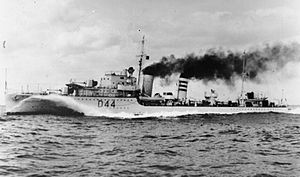 The three black bands on Imogen's aft funnel show her membership of the 3rd Destroyer Flotilla
| |
| History | |
|---|---|
| Name | Imogen |
| Ordered | 30 October 1935 |
| Builder | Hawthorn Leslie, Hebburn |
| Cost | £256,917 |
| Laid down | 18 January 1936 |
| Launched | 30 December 1936 |
| Completed | 2 June 1937 |
| Identification | Pennant number: D44 |
| Fate | Sunk in a collision with Glasgow, 16 July 1940 |
| General characteristics (as built) | |
| Class and type | I-class destroyer |
| Displacement | |
| Length | 323 ft (98.5 m) |
| Beam | 33 ft (10.1 m) |
| Draught | 12 ft 6 in (3.8 m) |
| Installed power |
|
| Propulsion | 2 shafts, 2 geared steam turbines |
| Speed | 35.5 knots (65.7 km/h; 40.9 mph) |
| Range | 5,500 nmi (10,200 km; 6,300 mi) at 15 knots (28 km/h; 17 mph) |
| Complement | 145 |
| Sensors and processing systems | ASDIC |
| Armament |
|
| Service record | |
| Victories: | |
HMS Imogen was a I-class destroyer built for the Royal Navy in the mid-1930s. During the Spanish Civil War of 1936–1939, the ship enforced the arms blockade imposed by Britain and France on both sides as part of the Mediterranean Fleet. After the start of the Second World War the ship was transferred to Home Fleet and participated in the Norwegian Campaign in April 1940. Imogen sank two German submarines before her own sinking following an accidental collision in July 1940.